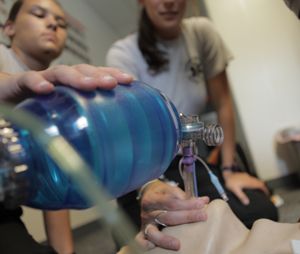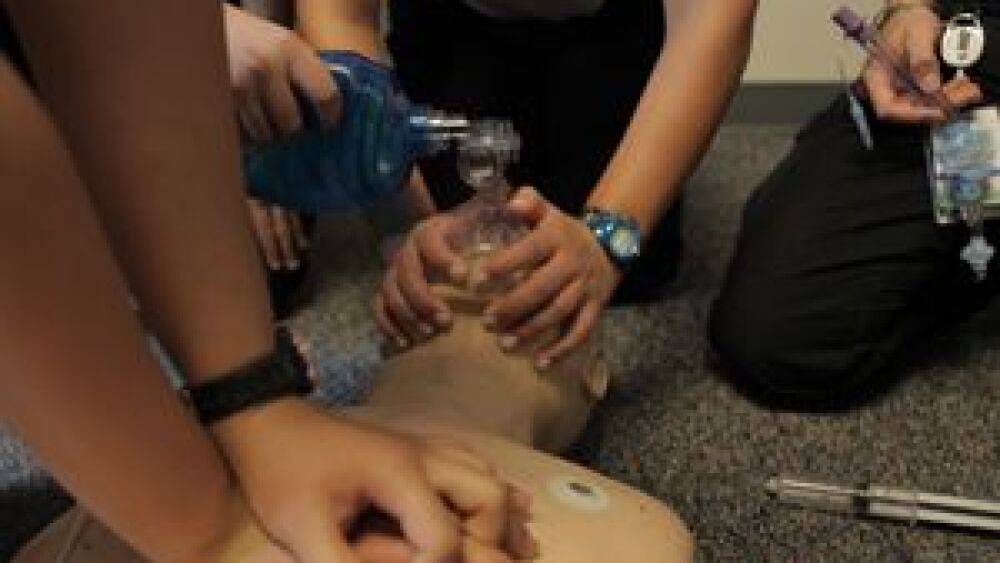By Lindsey Stein and Hilary Jacobson
Recruitment and retention is a significant challenge for most volunteer EMS agencies, and the Harrisonburg Rescue Squad (HRS) is no exception. The agency was founded in 1949 and today operates as one of the busiest stations in the state, answering over 8,100 calls annually (22-plus a day) with a 100 percent volunteer membership; one that is honored to serve the community and appreciates the opportunity to do so.
HRS call volume is on the rise and in order to preserve an all-volunteer status, the agency must continue to maintain a yearly net positive membership. Here are six recruitment and retention strategies that are working right now for HRS:
1. Promoting observer shifts, not membership
When the membership committee speaks with the public, they don’t recruit members; they recruit observers. It is much easier for someone to commit to spending four hours at the station than to a 48 hours-per-month membership, and if there is no initial buy-in, the recruitment process is not going to be successful.
Once observers arrive, the buy-in process begins. HRS members have positive attitudes that are contagious. They are all volunteers, but they run a professional organization. Members treat EMS like a job and a responsibility because despite no pay, they are always caring for someone’s loved one. Members are there because they want to be there and because they care about HRS remaining a vital community resource. When observers catch this vibe, they want to emulate and be a part of it.
2. A rigorous selection process
HRS’s selective membership process starts with determining who will be a good fit for the agency – a decision-making process that begins during the required observation shift. The HRS membership committee tracks people from the time they observe until the time they resign.
If an observer doesn’t apply immediately, their contact information is gathered, it is noted how they found out about the agency, and they receive reminders four times a year that applications are being accepted.
After an observer completes their ride-along, valuable crew feedback is solicited and reviewed. It is understood that not every observer is a good fit, and if someone doesn’t match HRS’s values of service, professionalism and dedication, the application will go no further.
If an observer applies for membership, they are interviewed by the membership committee to ensure they are applying for the right reasons and have a positive and motivated mindset. The HRS board of directors then makes the final decision as to whether or not the applicant will make a positive contribution to the agency. This rigorous process produces a well-selected pool of new recruits that have an excellent chance of success.
3. A strong emphasis on training
 |
| At HRS, recruitment success is a deliberate, constantly monitored process while retention is facilitated almost entirely by the culture. (Image Alex Sirney) |
Just as there are teaching hospitals, HRS is very much a teaching EMS agency. Members need only possess a valid driver’s license and CPR certification to join, and because there are so many new members coming in each month, current providers are constantly answering questions, reviewing protocols, and providing hands-on training with new and old members alike. This instills early on the importance of constantly working to better themselves as providers, and knowledge gives members pride in their agency and confidence in the field.
4. High expectations
Expectations are key to keeping members in once they’ve joined. At HRS, goals and responsibilities are introduced early on during the observer shift and interview process, and again during their first interactions after acceptance: training academy.
During the two-day academy, new members are given a comprehensive training packet with precise milestones and are told exactly how to accomplish each step. They are introduced to a structured, sequential precepting process that is designed to take members from zero experience to released as a driver or Attendant in Charge (AIC) in nine months or less. Once duty shifts begin, senior members reiterate these expectations and provide the training and guidance new members need to move forward. When new members understand what is expected of them and are given the tools to succeed, they stay motivated to progress.
5. Leadership opportunities accessible to all
HRS introduces numerous “career paths” to members early and guides them down leadership paths that complement their skills and interests. For example, a member with an interest in training may progress from a BLS preceptor to an ALS preceptor to a training officer. One with an interest in operational leadership may become a duty officer, then a deputy chief, and so on. Others may want to progress through special operations or driver training or specialized committees.
HRS wants those fulfilling both administrative and operational positions to be passionate about what they do. When positions are filled by people who are invested, the job is done better. When members are given ample opportunities to use special talents and leadership skills, they become increasingly invested in the agency.
6. Unique membership categories
While Harrisonburg is very much a college town, only 30 to 40 percent of HRS members are current college students. Specialized membership categories allow a greater variety of people to join who might just want to drive or participate in technical rescues. This keeps students coming back even after they graduate and move away, and allows for flexibility so that members with competing professional, educational, family, and other responsibilities can more easily fit HRS into their schedule. Simply put, more options in membership requirements allow more people to fit volunteering into their lives.
Despite these strategies, people do leave. The membership committee keeps in mind that their primary goal is to end with a net gain of new members each year to accommodate Harrisonburg-Rockingham’s growing demand.
At HRS, recruitment success is a deliberate, constantly monitored process while retention is facilitated almost entirely by the culture. Word-of-mouth is what brings the majority of HRS members in, but once they arrive, it’s the environment that retains them. HRS facilitates a positive culture with members who are dedicated to the mission and have fun doing what they love.
When members love what they do, they’re not going to stop. Typically when someone leaves HRS, it’s because of factors that can’t be controlled: they are graduating or moving, EMS is not for them, or they don’t have enough time. There is nothing that can be done to change that. All HRS can do is keep the right people coming in the door.
About the authors
Lindsey Stein is an HRS spokesperson who has been an operational member of the agency since 2009. She is a graduate of James Madison University.
Hilary Jacobson joined HRS in 2007. She has served on the membership committee as recruitment chair since 2008, and has been the overall membership committee chair since 2010. She is a volunteer and career Paramedic who is also a graduate of James Madison University.












